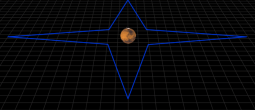

Vessel Orientation

Vessel orientation determines where other objects are positioned relative to the vessel’s current heading. This is an important consideration for a number of operational areas as it indicates which parts of the vessel are facing an object.
This determines which parts of the vessel are vulnerable to incoming fire, which of the vessel’s own weapons can be brought to bear against an object or which sensor systems are aligned to scan an object, for example.
Terminology
Vessel orientation is described using standard nautical terminology.
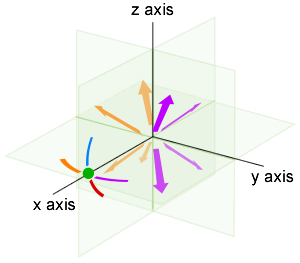 With the observer facing forward, an object to the left of the vessel is on the port side. An object to the right side is on the starboard side.
With the observer facing forward, an object to the left of the vessel is on the port side. An object to the right side is on the starboard side.
Bow: Forward sections of the vessel, used in conjunction with either port or starboard
eg starboard bow to designate the forward right of the vessel.
Quarter: Aft (rear) sections of the vessel, used in conjunction with either port or starboard
eg starboard quarter to designate the aft right of the vessel
Dorsal: Upper sections of the vessel.
Ventral: Lower sections of the vessel.
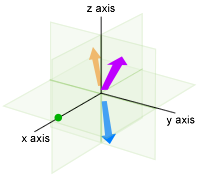 Combinations of these terms can be used to describe up to eight different directions.
Combinations of these terms can be used to describe up to eight different directions.
eg in the diagram to the left, the purple arrow points out the dorsal port bow. The orange arrow is points out the dorsal starboard quarter. The blue arrow points out the ventral port bow.
Anything directly aligned with the vessel may use the terms:
Ahead: directly ahead of the vessel
Astern: directly behind the vessel
Starboard/Port Beam: directly to starboard or port of the vessel (generically: abeam).
Profile Planes
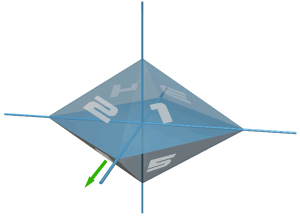 For operational and tactical purposes, the vessel is considered to have eight profile planes which can be visualised as an octahedron, with four upper planes facing forward and aft towards port and starboard respectively. This is mirrored by four lower planes.
For operational and tactical purposes, the vessel is considered to have eight profile planes which can be visualised as an octahedron, with four upper planes facing forward and aft towards port and starboard respectively. This is mirrored by four lower planes.
The profile planes are numbered in this order of priority: upper planes first, then forward planes first, then port plane first.
Orientation
Vessel orientation is normally calculated against a Tactically Significant Maneuvering Object TSMO in the Tactical Operating Environment (TOE). The relative grid position of the TSMO and each vessel's heading will determine their orientation to each other.
Bearing
The system calculates a bearing to the TSMO, which is used to determine which of our vessel's profile planes it is facing. A positive (port) bearing lower than 90° would put the TSMO off our port bow (as in the diagram below).
Direct Alignment
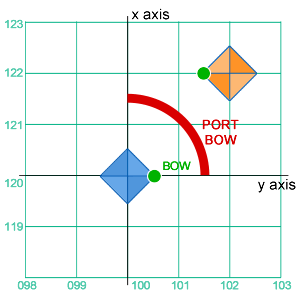 When vessels are directly aligned, then two profile planes will be facing simultaneously. This may present a tactical advantage to one or other vessel.
When vessels are directly aligned, then two profile planes will be facing simultaneously. This may present a tactical advantage to one or other vessel.
A zero bearing indicates a TSMO is ahead (directly aligned forward).
A 90° bearing indicates a TSMO is abeam (directly aligned port or starboard).
A 180° bearing indicates a TSMO is astern (directly aligned aft).
The vector will determine which of the upper or lower pair of planes is facing on a directly aligned bearing.
Vector
A vector is also calculated to the TSMO.A positive vector means the TSMO positioned above our vessel. In the diagram example, this means profile plane 1 (ventral port bow) is facing the TSMO. If te vector was negative; profile plane 5 would be facing.
Direct Alignment
A zero vector indicates direct vertical alignment. When combined with a directly aligned bearing, this means four profile planes may be facing simultaneously.
TSMO Profile Plane
It is also useful to know which of the TSMO's profile plane is facing our vessel. In the diagram example, The TSMO has a heading of 270° which means our vessel is located off its port bow. If the TSMO was above us, its profile plane 5 (dorsal port bow) would be facing us.
Range
Range is used to determine the accuracy and impact of weapons fire and vessel detectability..
The system calculates the range of a TSMO from the vessel by triangulating bearing and position.




